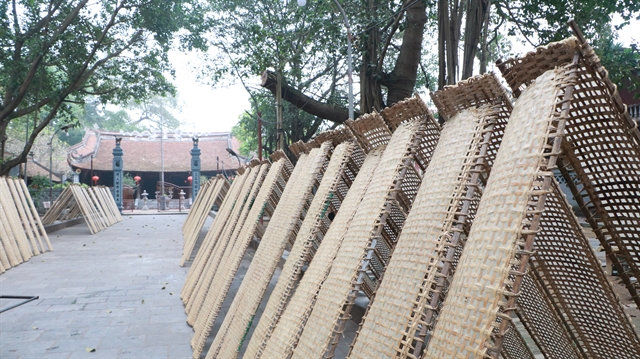Rice paper phenomenon sweeps through Vietnamese village
HANOI (ANN/VNS) – As you journey through Thổ Hà, an age-old village nestled along the banks of the Cầu River in Bắc Giang Province, you’ll find yourself intrigued by the bamboo racks lining the roadsides. These racks serve as platforms for drying rice paper and rice crackers, cherished specialties that embody the village’s time-honoured culinary tradition. The villagers adorn the landscape with these racks, placing them along roadsides, near communal houses, and even atop house roofs, imparting a distinctive charm to the surroundings.
Rice paper has been synonymous with this village for generations.
”Nearly 90 per cent of the people in the village make rice paper while the remaining produce rice crackers,” Nguyễn Thị Mai, a resident whose family has been working here for three generations, told Việt Nam News.

Special feature
Making rice paper requires meticulousness, from selecting white rice, soaking in water, grinding into fine batter, spreading the mixture on hot plate to cook, and sun drying. A little haste can ruin a whole batch of the product.
The ingredients for making rice paper are simple but crucial: quality rice.
“In other places, people mix refined cassava and arrowroot flour, but here, we only use quality rice flour. Nothing else is added,” Mai said.
“The rice flour used here is finer. Therefore, our sheets of rice paper are pliable. They do not break easily when wrapped.”
Before becoming the perfect ‘blanket’ to wrap up meat and other ingredients for spring rolls, these sheets are dried in the sun — a process that can be challenging, depending on the weather.
“On sunny days, drying takes two to three hours, but it may take all day in humid conditions. If it rains, the paper will easily become mouldy or if it is dried under strong sunlight, the paper will easily crack,” said Mai.
“A hundred round sheets sell for about VNĐ25,000. Nowadays, with application of machines, productivity has increased significantly. We can produce around 3,500 sheets of rice paper in just one hour,” she said.

Famed trademark
Thổ Hà Village is also renowned for its rice crackers.
Trịnh Đắc Hạnh told Việt Nam News that since he was young, his grandparents and parents had made rice crackers.
“I watched them and then I learned and followed the craft,” he said.
The production process now involves spreading rice batter on a hot plate, cooking it briefly before adding another layer, and then steaming it for a minute. Roasted peanuts and shredded coconut meat are sprinkled on top before the cake is flattened and hung on bamboo racks to dry.
Hạnh’s family continues to follow traditional methods, producing up to 200 sheets of rice cracker a day.
“I usually work from 4am to around 7pm. Each sheet currently sells for VNĐ15,000,” he said, while his hands continuously flipped the sheets during the grilling process.
According to Trịnh Thị Tám, a rice cracker maker, grilling is the most difficult part of the rice cracker-making process. The heat in the stove is extremely hot.
“It is also hot when people dry rice crackers in the sun. When there is no sunshine, we have to machines to dry them inside our workshop. It is a tough job, but the local people are still attached it,” she said.
The rice paper and rice crackers from Thổ Hà are not only staples in Vietnamese cuisine but also popular gifts for visitors. Many tourists in the village purchase the special products for their relatives and friends, further spreading the fame of Thổ Hà’s culinary heritage. – ANH NGO






